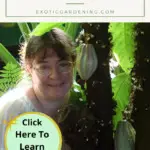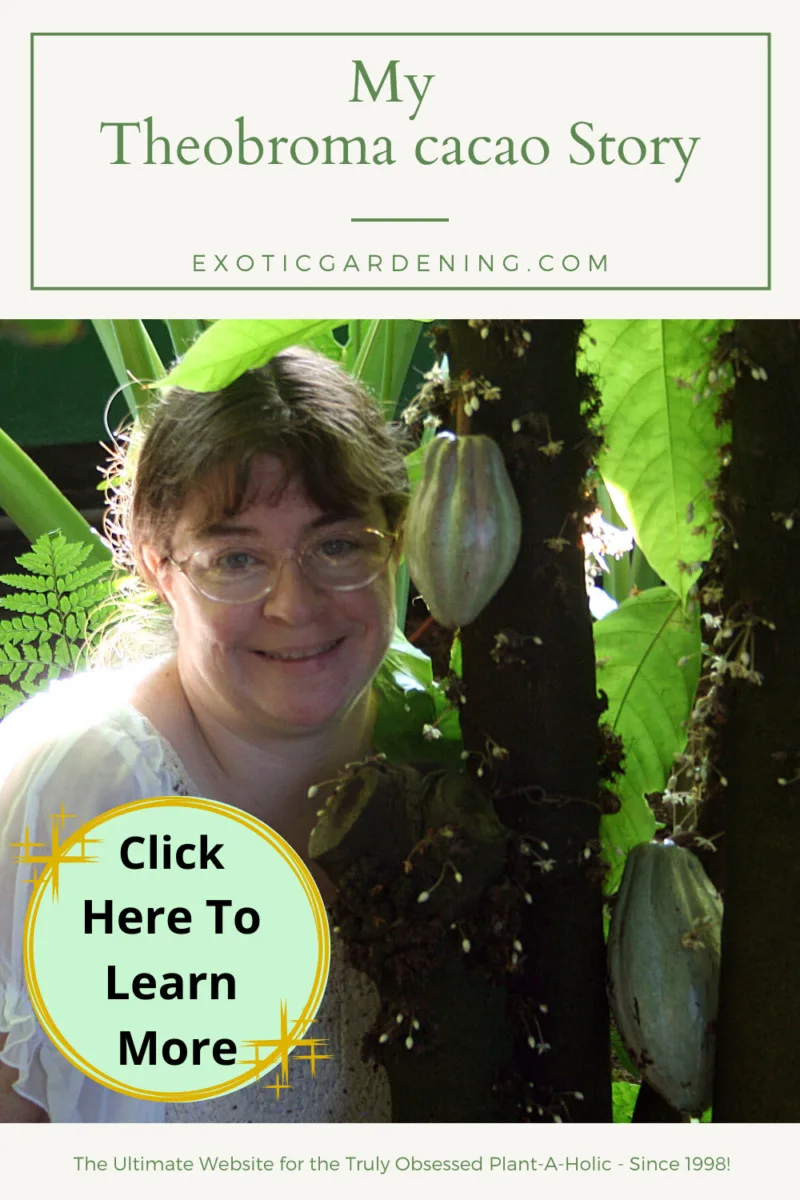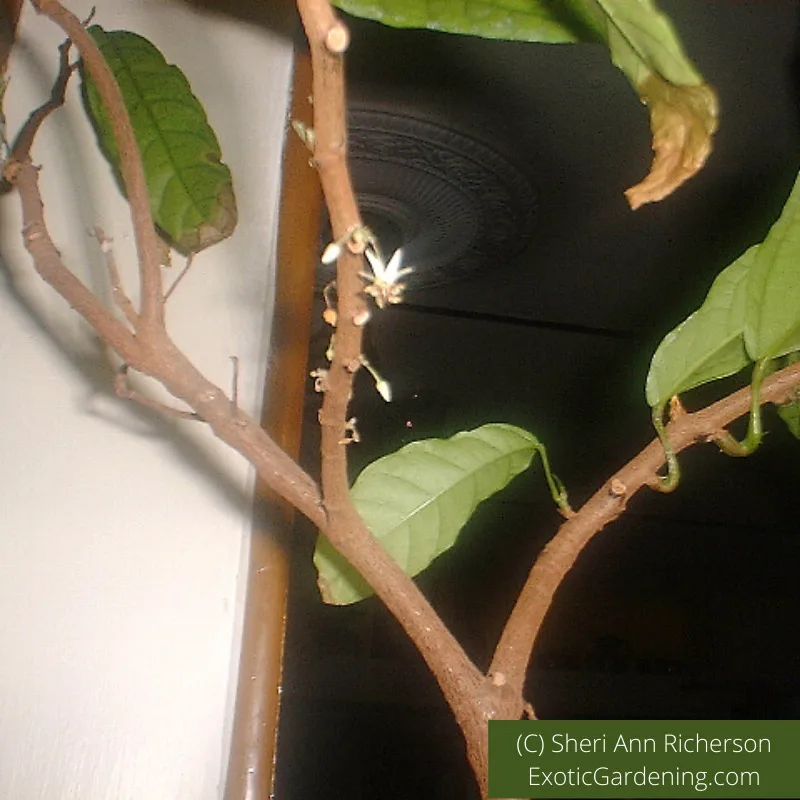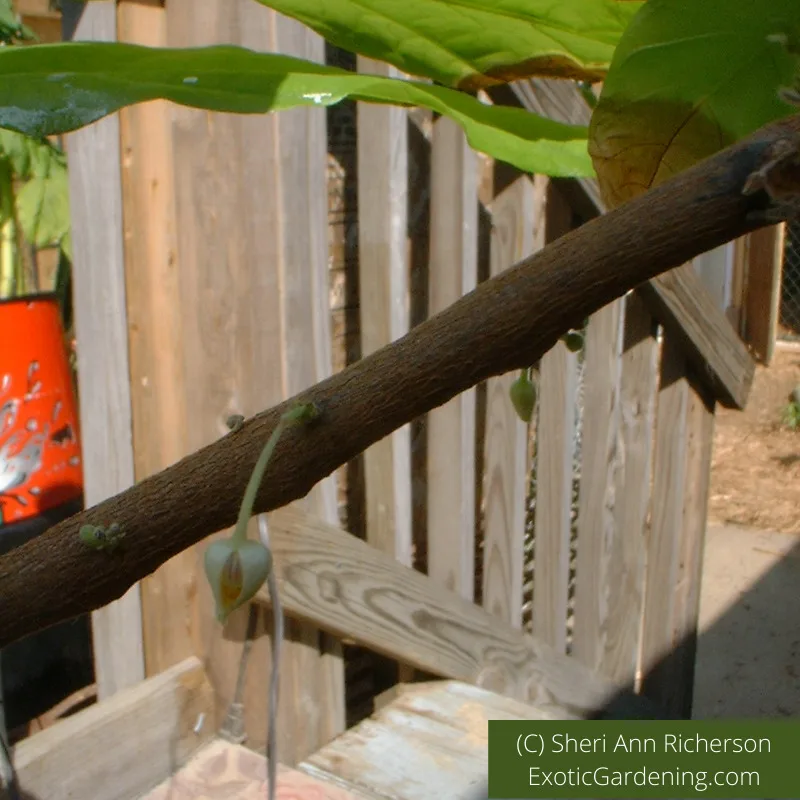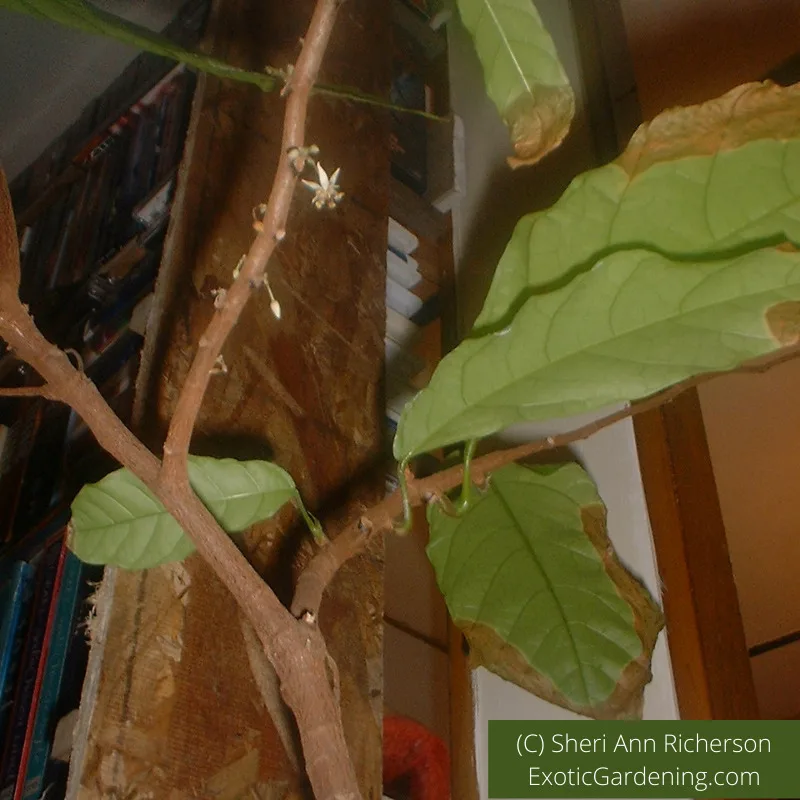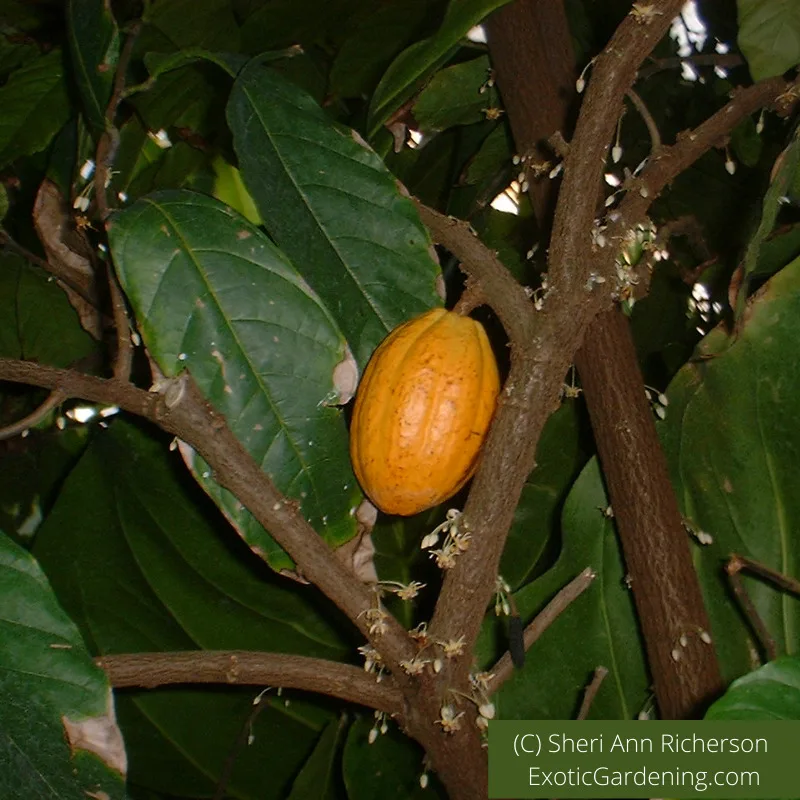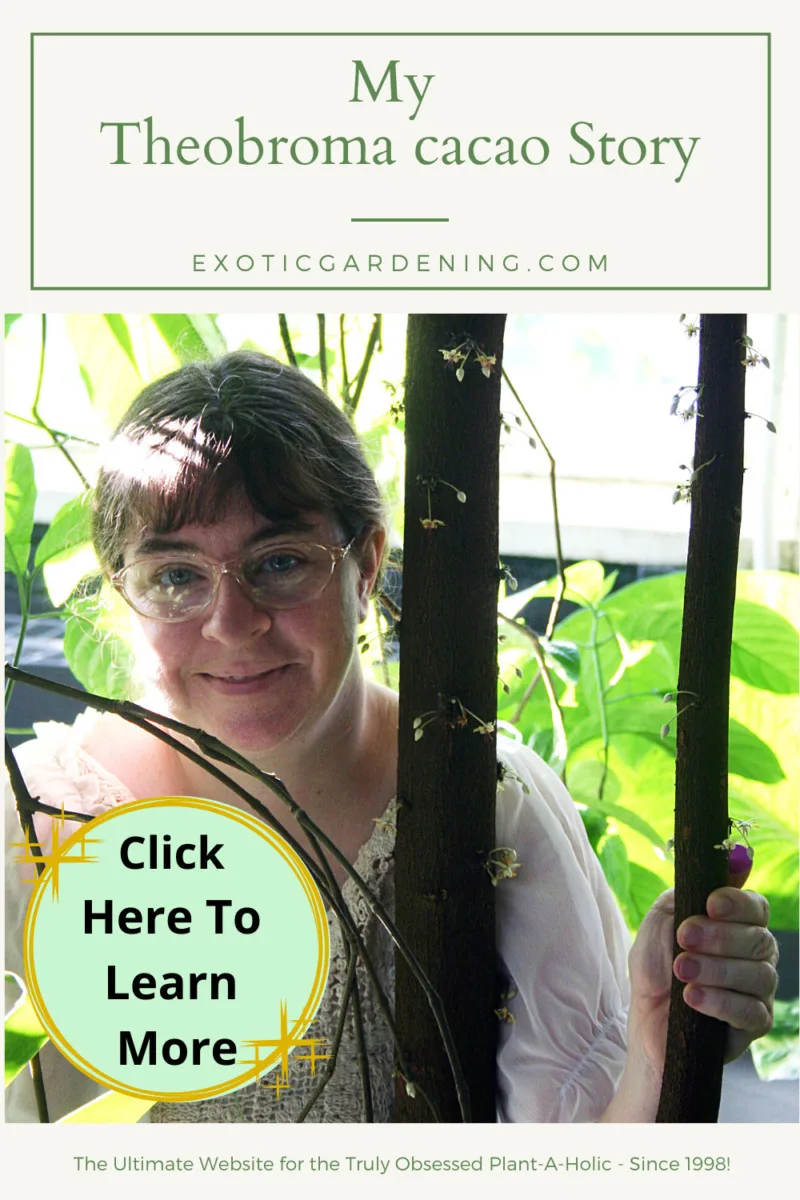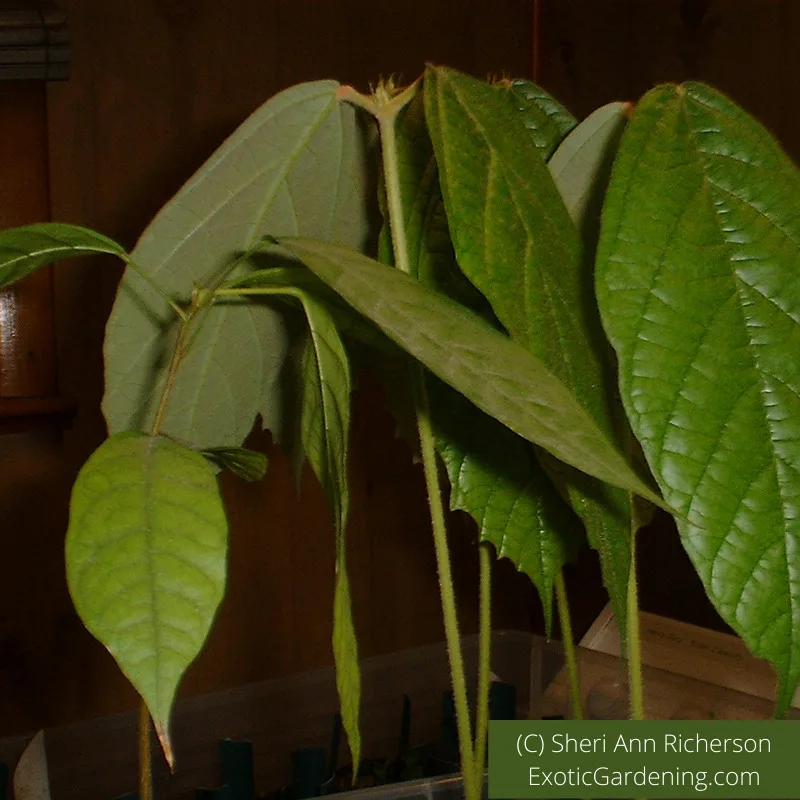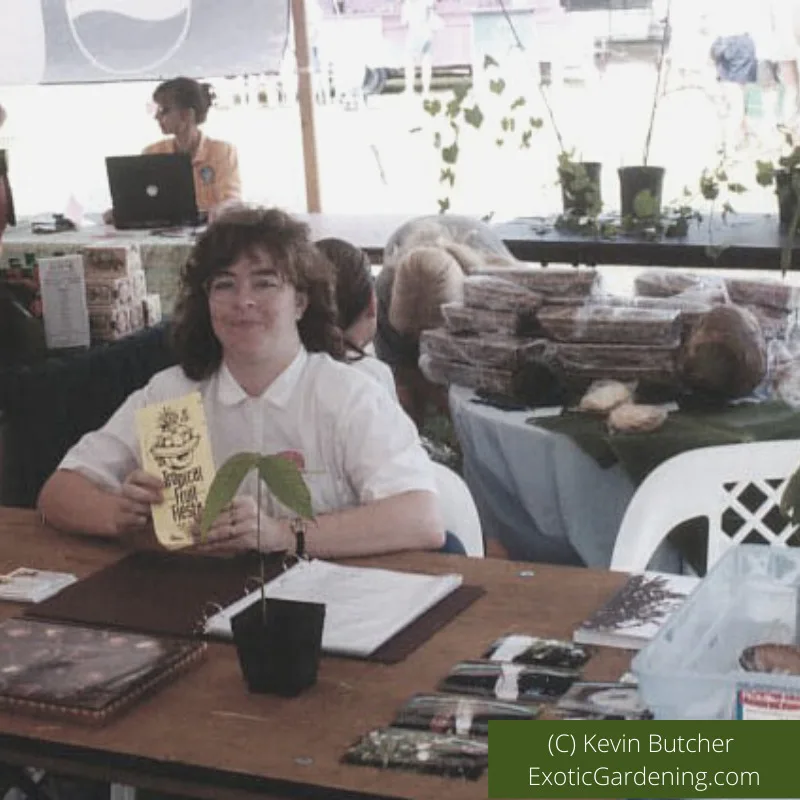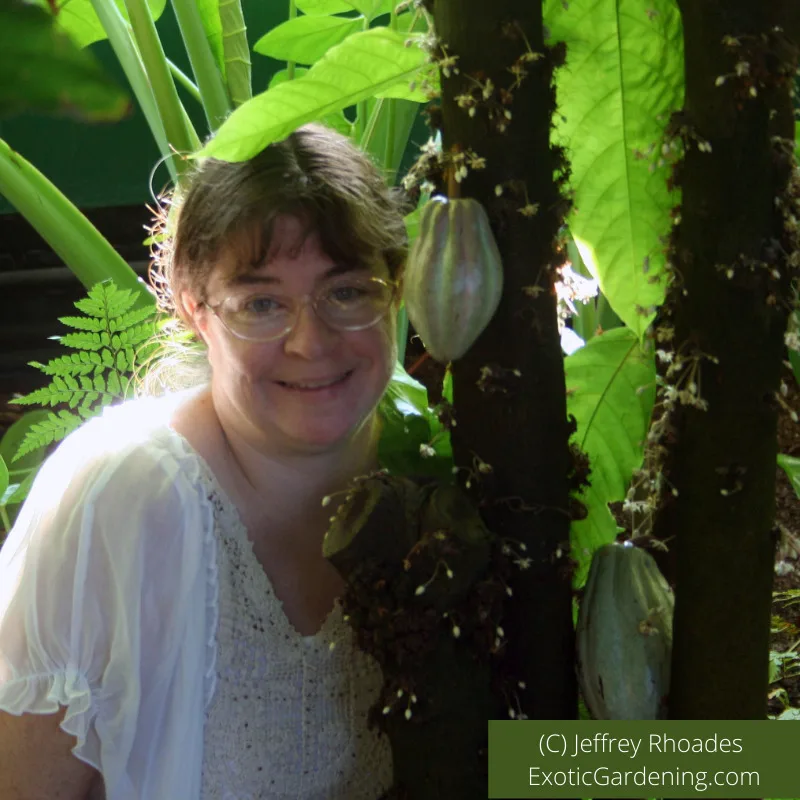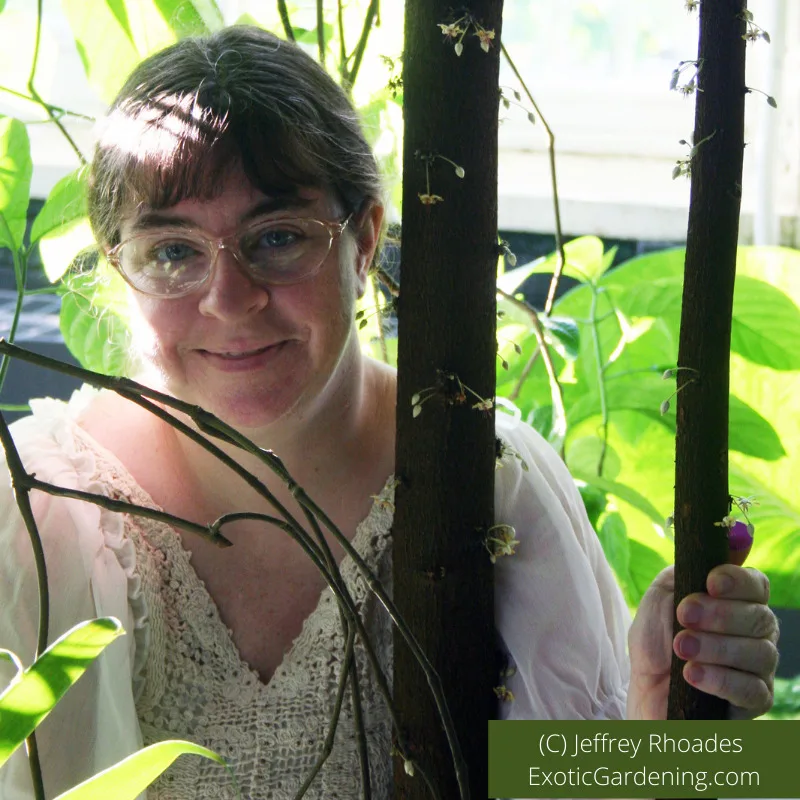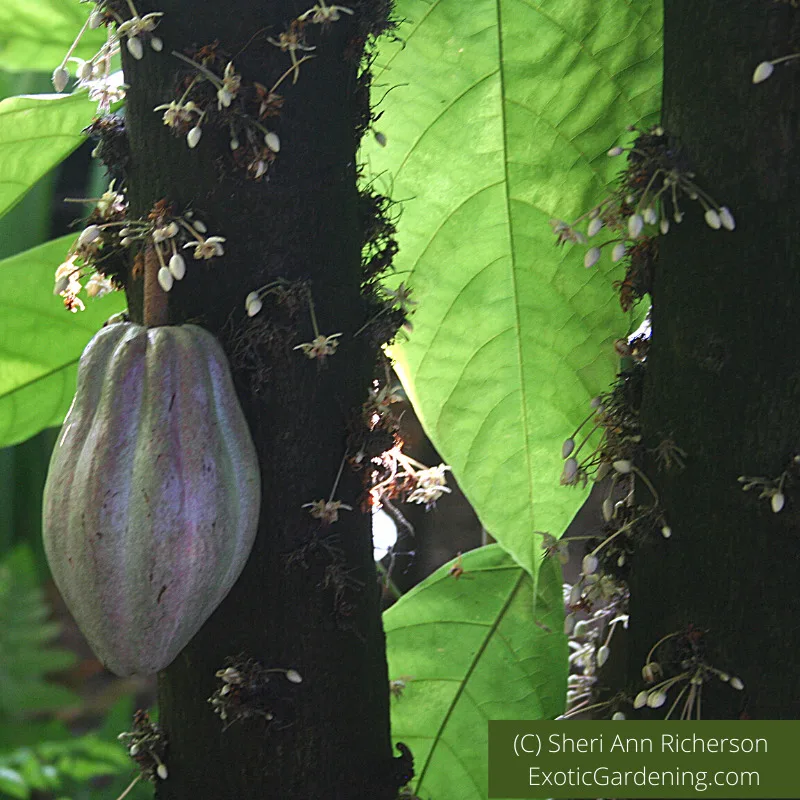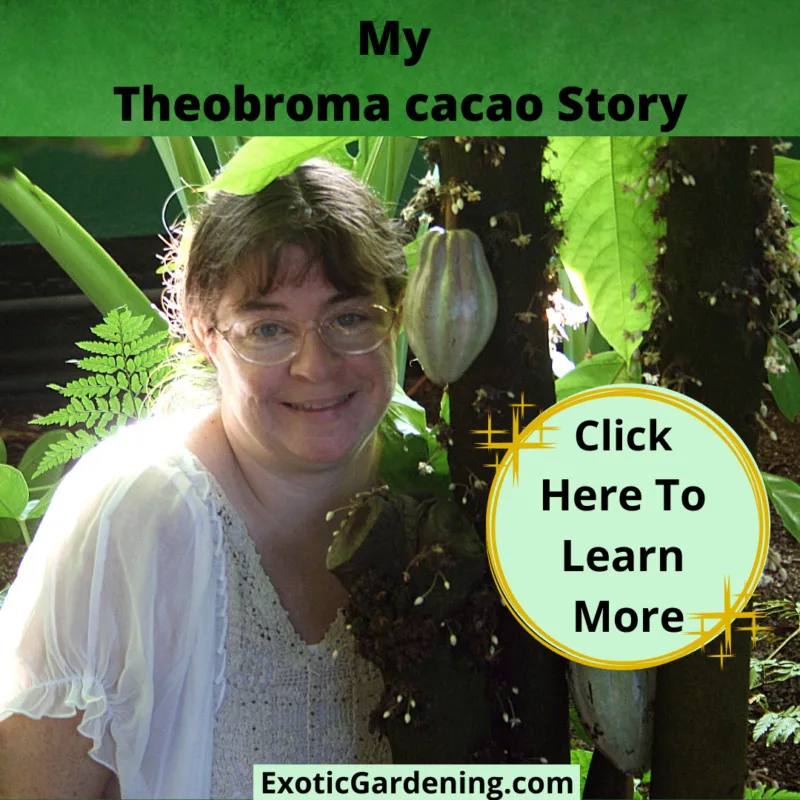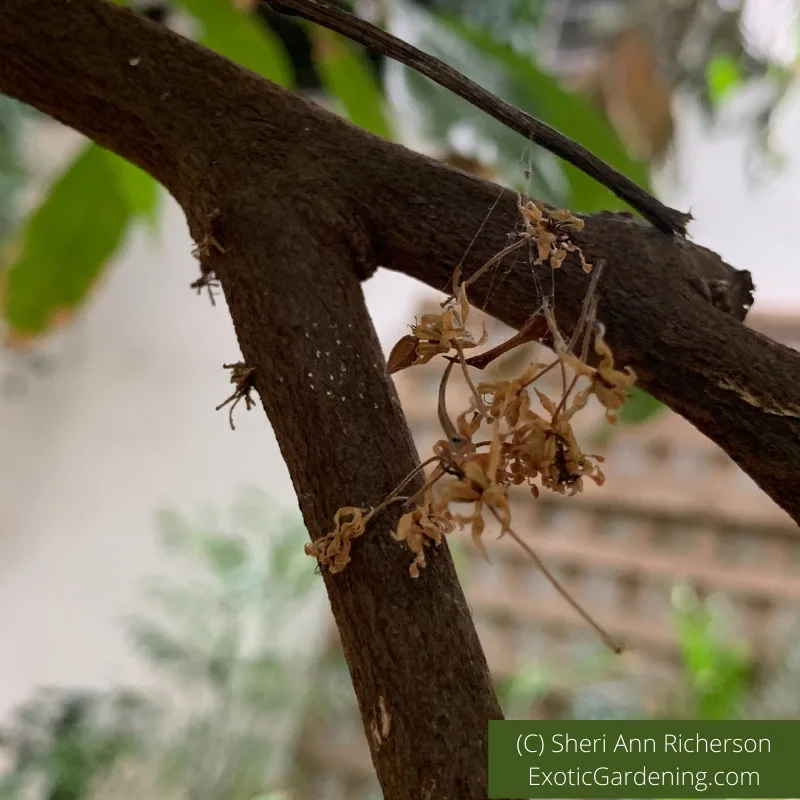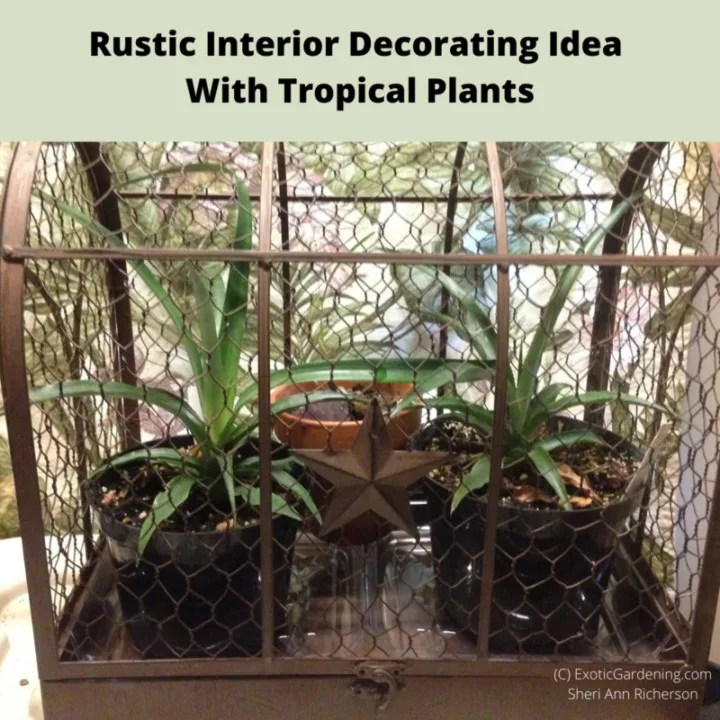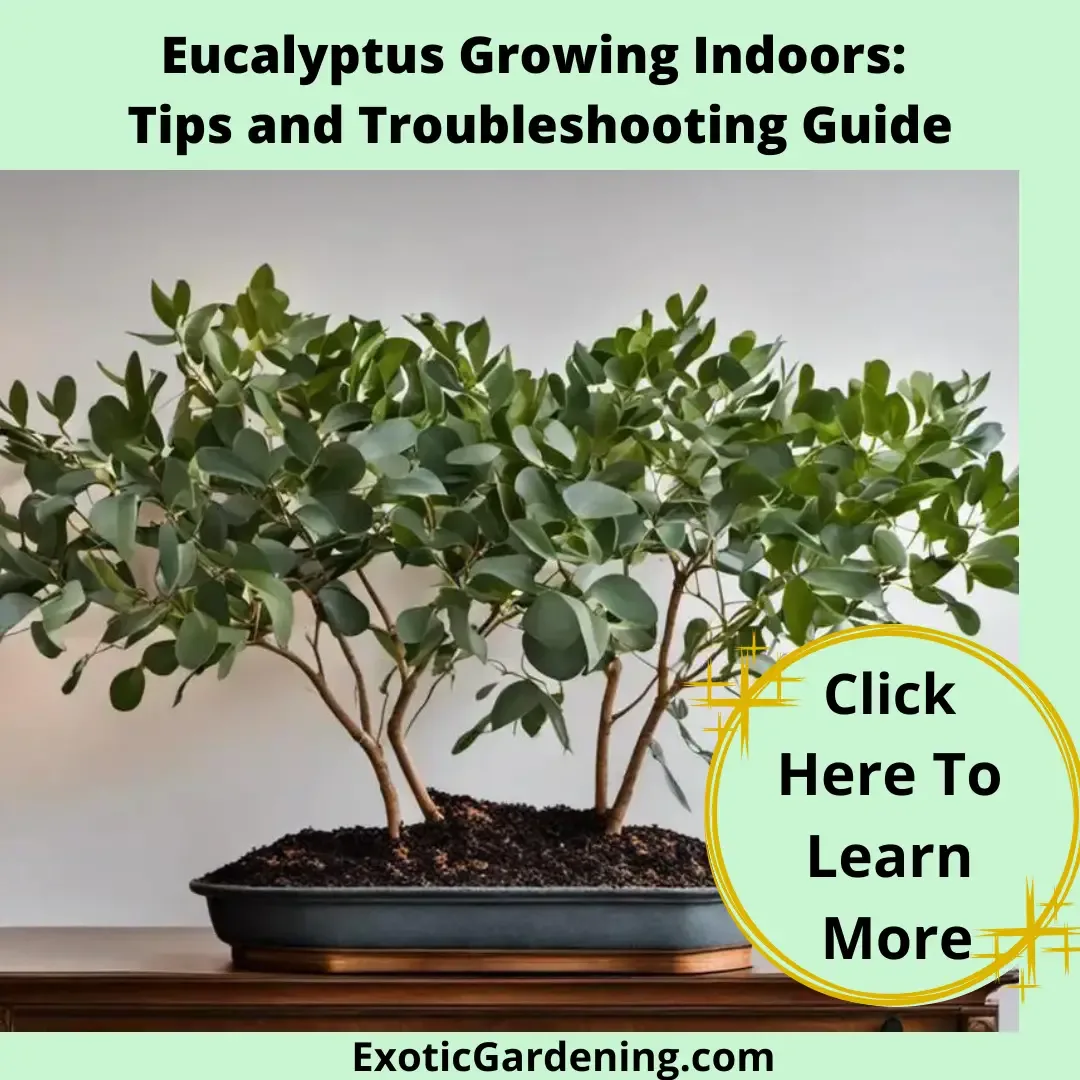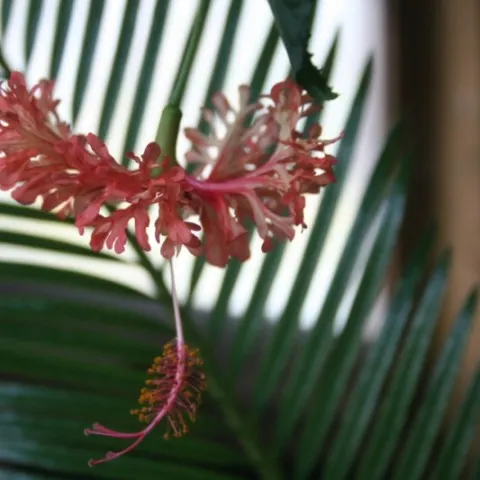My Theobroma cacao story began the moment I learned that this was the plant chocolate actually came from.
My quest to learn more about this particular plant has taken me many places – Chicago, New York, Key West, all over Indiana and I even ended up making a good friend in Puerto Rico who grows many varieties of Theobroma.
Through this friend I have been lucky enough to acquire pods of different types of Theobroma, including some brand new varieties, that I was then able to try my hand at growing them here in Indiana as houseplants.
What I can tell you is that growing this tropical plant in a container is possible and yes, you can get the plant to bloom with a little patience.
My Theobroma cacao Story Started In Indiana
Back in the late 1990’s there was a site called GardenWeb.
It was the place for people who loved plants to hang out and meet other similar minded people.
I was new to gardening back then but quickly found out just how much I loved tropical plants.
People would send me this plant or that plant and of course, I had to grow them just to see if they would thrive in a cold climate indoors during the winter.
Within a few months I decided to volunteer at the Foellinger-Freimann Botanical Conservatory in Fort Wayne, Indiana so I could gain information and have access to seeds, cuttings and sometimes entire plants they were selling or getting rid of.
Then someone offered me a Theobroma cacao plant in trade.
I was over the moon!
It was a huge plant that needed to be put into a five gallon pot when it arrived.
Sadly the leaves kept falling off and it seemed it was dying.
I did some research, learned it needed a flood/dry/flood watering cycle and high humidity.
I put a saucer under the plant and filled it halfway up with pebbles.
I added some composted horse manure to the soil in the pot to mimic the rich soil of the Amazon Rainforest.
I then filled the saucer with water, stuck bamboo sticks around the inside edge of the pot and wrapped the entire plant – from the bottom of the saucer to the top of the plant – in Saran Wrap.
The Theobroma cacao tree started putting out new leaves and I slowly began to expose it to air.
Each week I removed a little more Saran Wrap, making sure to mist it several times a day.
Then one day the Saran Wrap was completely gone.
Two years later I came home to find my little Theobroma cacao tree, still in the original five gallon pot I had first planted it in, had bloomed.
Coming home after attending the Garden Writers Association Annual Symposium to find my Theobroma cacao plant in bloom was absolutely amazing.
Of course, one of the harder parts of growing Theobroma cacao as a houseplant is keeping the humidity high enough that the leaves don’t dry out.
The leaves on my tree looked really good when I left, but a week later they were looking pretty ratty from a lack of humidity.
I was kind of worried at this point and concerned I would lose my tree, but I knew the issue was not enough humidity.
I had put it inside during my trip because I was afraid the hot outside temperatures would be too much without regular watering.
My solution was to place it back outside in a shady spot and use my hummingbird mister to make sure it stayed continually moist.
I did not use a saucer underneath the plant during this time.
The Next Chapter Of My Theobroma cacao Story Lead Me To Chicago
Of course, when you find a new plant to grow, you want to know all about it.
I made several trips to Chicago to learn more about the Theobroma cacao tree and the history of chocolate.
I visited botanical gardens that had the trees in bloom or had pods on them.
I stood in line for several hours to get into a chocolate festival at a local botanical garden there.
I even went to an exhibit on chocolate at the Field Museum in Chicago.
Wolfgang Puck did a cooking exhibit, there was a 300 pound chocolate dinosaur I was able to observe and of course there was lots of information on Theobroma cacao.
The more I learned, the more fascinated with the plant I was.
The Search For Theobroma cacao Pods
Once I met Bryan through GardenWeb, I had a way to get a Theobroma cacao pod whenever I wanted one as long as it was the right time of the year for the trees to produce pods.
Bryan eventually started a website called Montoso Gardens.
He has been an absolute wealth of information over the years.
He has sent so many different varieties of Theobroma, just so I could see them and learn about them.
He has answered questions and really helped me understand how to successfully grow this plant.
Not to mention when I decided it was time to try to make my own chocolate from scratch, he guided me.
Of course, homemade chocolate, as he warned me, without the right equipment is not smooth like store bought chocolate, but I didn’t care.
The point was I was learning how to make chocolate the way they did long before fancy equipment was available.
I quickly learned the best way to germinate Theobroma cacao seeds was in damp paper towels.
Before long I was growing lots of Theobroma cacao seedlings.
Speaking At The Key West Tropical Fruit Fiesta
I’ve spent a lot of my time over the past 20 years giving presentations and making videos on how to grow chocolate.
From small garden clubs to state conventions, each presentation is slightly different, but I try to cover the basics of the history of chocolate, how to germinate and grow the plant as well as offering people the chance to either take a home a seed for free or purchase a seedling.
However, I have to say when I was asked to speak at the Key West Tropical Fruit Fiesta my heart skipped a beat.
I wondered what on earth I could offer information wise to people who lived in a warm climate and could easily grow this tree themselves.
The temptation was too strong to resist though, so I accepted.
I took a lot of small seedlings with me and quite a bit of information.
I was surprised people responded so positively and actually wanted to buy the seedlings.
I sold out so fast my head was spinning!
I spoke about how they remove the seeds from the pods, place the seeds in the ground and cover them with banana leaves to ferment them.
A man was standing there listening carefully to every word I said.
When I was done talking, he approached me and asked me how I knew the process.
I felt a bit intimidated as I had only done research and never actually been to a cacao farm where they do this.
I was honest with him though.
When he said I had the process exactly right and this was how it was still done today, I felt relieved.
He told me he worked on a cacao plantation.
I was in the right place at the right time to receive the confirmation I needed that all the research I had done was absolutely correct.
The New York Botanical Garden And My Theobroma cacao Story
Then the offer came to speak at the New York Botanical Garden on Theobroma cacao.
I was scared to death when that email came.
I do not have a horticultural degree.
I did become a Gold Level Master Gardener.
I did belong to the Garden Writers Association.
I did do a lot of research and reading to learn what I know.
But did I really belong at the New York Botanical Garden giving a presentation?
Oh my!
I was terrified and unfortunately turned down the offer.
I regret doing that now, but at the time I just was too terrified.
I did finally get to go there as a visitor however.
The New York Botanical Garden is truly an amazing place to visit.
I went during the Monet Garden Exhibition.
Of course, what thrilled me the most was seeing a gorgeous Theobroma cacao tree that was filled with both blossoms and pods.
It was right at the edge of the walkway, so I was able to get a few photos of myself with that tree as well as some really great photos of the pods on the tree trunks and not just hanging from the branches.
While I would not encourage anyone to just go trotting through the plantings at a Botanical Garden, I did, but I did so very carefully making sure not to step on anything that was visible above the ground.
I stayed quite close to the tree trunk itself and made sure not to knock any of the flowers or cacao pods off.
The last thing I would ever want to do it damage a plant.
In its native environment, this the pods grow on both the trunks as you see in the photo above as well as on the branches of the tree.
This was the first time I had seen the pods growing on the lower trunk of the tree.
Most botanical gardens remove the lower flowers and pods.
I assume this is so people are not tempted to touch them or remove them.
More Than Twenty Years Later My Theobroma cacao Story Isn’t Over
It’s been more than twenty years since my fascination with growing Theobroma cacao first began, but I can tell you the excitement of growing this plant – or even seeing one at a botanical garden – is still just as strong as it was when I began.
I am still doing the occasional presentation and of course, still starting the plants from seed.
I’ve lost more than my share of Theobroma cacao through the years, mostly due to power outages in our area.
These are tropical plants that just do not tolerate frigid temperatures.
I still go to botanical gardens to see how their Theobroma cacao trees are doing and to see if I can catch them in bloom or better yet, filled with pods.
I recently visited the Foellinger-Freimann Botanical Conservatory in Fort Wayne, Indiana again and I was able to observe a Theobroma cacao tree that had both dried blooms and pods in different stages on it.
What is so strange about this is I wondered if this tree was grown from one of the seedlings I left there years ago when I gave a presentation there during one of their luncheons.
There was no one there to ask, so I guess I will never know.
The blooms truly fascinate me because they are so tiny that if they did not grow in clusters, you might miss seeing them.
Many of the blooms were dried up on this particular tree.
Midges pollinate them in their natural environment, but no one I have asked seems to know how they end up being pollinated in places midges don’t live.
While it is obvious that hand-pollination is an option, when you see really large Theobroma cacao trees in Botanical Gardens that are filled with pods in different stages of development, you pretty much know that hand-pollination is not how that happened.
Something that did strike me as odd with this Theobroma cacao tree was that they pods were severely dried up, there were broken tree branches and numerous dried leaves.
This was the first Theobroma cacao tree I had seen in this bad of shape and I have to wonder why.
Possibly the pandemic, but I honestly do not know.
As for me, my Theobroma cacao story is long from over.
I have a shipment with a pod in it arriving any day now and I intend to grow another round of seedlings.
I don’t know where my next presentation might be, or if the book proposal ‘Gardening For Chocolate Lovers’ that Tom Ogren and I sent to our agent will ever find a publisher.
What I do know is I still love growing this plant and it most definitely belongs in my personal plant collection.
Tropical Fruit And Foliage Plants
Tropical Plants For Medium To High Light
Check out these awesome tropcial plants for medium to high light that make wonderful, easy to care for houseplants.
Caring for Indoor Palm Plants: Tips for Thriving Green Beauties
Discover expert tips for caring for indoor palm plants, ensuring their vitality and adding a touch of tropical elegance to your space.
How To Grow Cinnamon
Learn how to grow cinnamon from seed or cuttings. Cinnamon trees do well as houseplants even though they can get rather large.
How To Grow And Harvest Pineapple From Home
Learning how to grow and harvest pineapple is a fun project that anyone in any climate can experience as long as they are patient.
Colorful Foliage Plants
Try these colorful foliage plants in your garden this summer and then bring them indoors during the winter to brighten up your home decor.
Easy Exotic Houseplants: Tropicals That Thrive Indoors in Containers
Tropical plants are the most beautiful, easy to grow indoor houseplants. Start growing exotic houseplants today that fruit and flower!
Eucalyptus Growing Indoors: Tips and Troubleshooting Guide
Discover the art of eucalyptus growing indoors for year-round beauty and fragrant cut foliage in your flower arrangements.
Scented Grass Adds Natural Fragrance To The Home Or Garden
Scented grass is one way to add scent to your garden or even your home. Best of all, they look pretty, smell great and have practical uses.
Learning About Bananas
Once you start learning about bananas you may find this popular and important fruit is really quite fascinating and makes a great houseplant.
The Enigmatic Elegance: A Comprehensive Guide to Philodendron Florida Ghost Care
Elevate your indoor gardening with our guide to Philodendron Florida Ghost care, propagation, and maintenance tips.
Incorporating Bold And Exotic Plants Into Your Landscape
Discover the allure of bold and exotic plants for your garden in this comprehensive guide. Transform your landscape today!
Variegated And Other Interesting Plants: Elevate Your Space with Nature's Painted Wonders
Explore the world of variegated and unique plants, adding vibrant beauty and intrigue to your indoor oasis.
How To Grow Tropical Plants
Growing tropical plants - also known as houseplants - indoors is fun and enjoyable plus many of them clean the indoor of pollutants.
It is easy to grow exotic looking plants that produce tropical fruit and colorful flowers in a pot in your living room or office.
Many of these plants are easy to start from seed and I share with you five plants that I recommend for indoor growing.
I also share with you why growing your own tropical fruit saves money.
In this video you will learn:
How to bring tropical plants indoors at the end of summer
How to grow tropical plants indoors
How to protect and overwinter tropical plants outdoors in cold climates
How to propagate tropical plants
How to water tropcial plants
How to grow topical plants in a greenhouse


